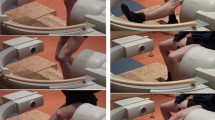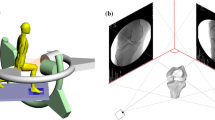Abstract
Background
In vivo studies have suggested Caucasians achieve lower average knee flexion than non-Western populations. Some previous studies have also suggested gender may influence condylar AP translation and axial rotation, while others report an absence of such an influence.
Questions/purposes
We determined whether different ethnic and gender groups residing in the United States had different knee translations and rotations.
Methods
Three-dimensional knee rotations and translations were determined for 72 healthy subjects (24 Caucasian men, 24 Caucasian women, 13 Japanese men, 11 Japanese women) from full extension to maximum flexion using a fluoroscopic technique, under in vivo, weightbearing conditions.
Results
Although we observed substantial variability in all groups, small differences between groups were found, especially in deep flexion. Japanese women and men and Caucasian women achieved higher maximum flexion (153°, 151°, and 152°, respectively) than Caucasian men (146°). External rotation was higher for these three groups than for Caucasian men. The medial condyle remained more anterior for Caucasian women and all Japanese subjects than for Caucasian men, possibly leading to greater axial rotation and flexion, observed for these three groups.
Conclusion
We identified small differences in maximum flexion between genders and ethnic groups. While no differences were identified in the lateral condyle translation, the medial condyle remained more stationary and more anterior for the groups that achieved highest (and similar) maximum flexion. Therefore, it may be important for future implant designs to incorporate these characteristics, such that only the lateral condyle experiences greater posterior femoral rollback, while the medial condyle remains more stationary throughout flexion.










Similar content being viewed by others
References
Ahlberg A, Moussa M, Al-Nahdi M. On geographical variations in the normal range of joint motion. Clin Orthop Relat Res. 1988;234:229–231.
Anderson B, Burke E. Scientific, medical, and practical aspects of stretching. Clin Sports Med. 1991;10:63–86.
Andriacchi TP, Dyrby CO, Johnson TS. The use of functional analysis in evaluating knee kinematics. Clin Orthop Relat Res. 2003;410:44–53.
Asano T, Akagi M, Tanaka K, Tamura J, Nakamura T. In vivo three-dimensional knee kinematics using a biplanar image-matching technique. Clin Orthop Relat Res. 2001;388:157–166.
Austin B. Physical activity/exercise. In: Olshansky E, ed. Integrated Women’s Health: Holistic Approaches for Comprehensive Care. Gaithersburg, MD: Aspen Publishers, Inc; 2000:103.
Barnett C. Locking at the knee joint. J Anat. 1953;87:91–95.
Blaha J, Wojtys E. Motion and stability of the knee. In: Scott WN, ed. Surgery of the Knee. 4th ed. New York, NY: Churchill Livingstone; 2005:227–239.
Cates HE, Komistek RD, Mahfouz MR, Schmidt MA, Anderle M. In vivo comparison of knee kinematics for subjects having either a posterior stabilized or cruciate retaining high-flexion total knee arthroplasty. J Arthroplasty. 2008;23:1057–1067.
Chappell JD, Yu B, Kirkendall DT, Garrett WE. A comparison of knee kinetics between male and female recreational athletes in stop-jump tasks. Am J Sports Med. 2002;30:261–267.
Decker MJ, Torry MR, Wyland DJ, Sterett WI, Richard Steadman J. Gender differences in lower extremity kinematics, kinetics and energy absorption during landing. Clin Biomech (Bristol, Avon). 2003;18:662–669.
DeFrate LE, Sun H, Gill TJ, Rubash HE, Li G. In vivo tibiofemoral contact analysis using 3D MRI-based knee models. J Biomech. 2004;37:1499–1504.
Dennis DA, Komistek RD, Colwell CE Jr, Ranawat CS, Scott RD, Thornhill TS, Lapp MA. In vivo anteroposterior femorotibial translation of total knee arthroplasty: a multicenter analysis. Clin Orthop Relat Res. 1998;356:47–57.
Dennis DA, Komistek RD, Hoff WA, Gabriel SM. In vivo knee kinematics derived using an inverse perspective technique. Clin Orthop Relat Res. 1996;331:107–117.
Dennis DA, Mahfouz MR, Komistek RD, Hoff W. In vivo determination of normal and anterior cruciate ligament-deficient knee kinematics. J Biomech. 2005;38:241–253.
Freeman MA. How the knee moves. Curr Orthop. 2001;15:444–450.
Freeman MA, Pinskerova V. The movement of the knee studied by magnetic resonance imaging. Clin Orthop Relat Res. 2003;410:35–43.
Freeman MA, Pinskerova V. The movement of the normal tibio-femoral joint. J Biomech. 2005;38:197–208.
Fuss F. Principles and mechanisms of automatic rotation during terminal extension in the human knee joint. J Anat. 1992;180(Pt 2):297–304.
Grood ES, Suntay WJ. A joint coordinate system for the clinical description of three-dimensional motions: application to the knee. J Biomech Eng. 1983;105:136–144.
Hallen L, Lindahl O. The “screw-home” movement in the knee joint. Acta Orthop Scand, 1966;37:97–106.
Hayter A. A proof of the conjecture that the Tukey-Kramer multiple comparisons procedure is conservative. Ann Stat. 1984;12:61–75.
Hefzy MS, Kelly BP, Cooke TD. Kinematics of the knee joint in deep flexion: a radiographic assessment. Med Eng Phys. 1998;20:302–307.
Heitz NA, Eisenman PA, Beck CL, Walker JA. Hormonal changes throughout the menstrual cycle and increased anterior cruciate ligament laxity in females. J Athl Train. 1999;34:144–149.
Hemmerich A, Brown H, Smith S, Marthandam SS, Wyss UP. Hip, knee, and ankle kinematics of high range of motion activities of daily living, J Orthop Res. 2006;24:770–781.
Hoff WA, Komistek RD, Dennis DA, Gabrietl SM, Walker SA. Three-dimensional determination of femoral-tibial contact positions under in vivo conditions using fluoroscopy. Clin Biomech (Bristol, Avon). 1998;13:455–472.
Hollman JH, Deusinger RH, Van Dillen LR, Matava MJ. Gender differences in surface rolling and gliding kinematics of the knee. Clin Orthop Relat Res. 2003;413:208–221.
Hovinga KR, Lerner AL. Anatomic variations between Japanese and Caucasian populations in the healthy young adult knee joint. J Orthop Res. 2009;27:1191–1196.
Hsu WH, Fisk JA, Yamamoto Y, Debski RE, Woo SL. Differences in torsional joint stiffness of the knee between genders. Am J Sports Med. 2006;34:765–770.
Iwaki H, Pinskerova V, Freeman MA. Tibiofemoral movement 1: the shapes and relative movements of the femur and tibia in the unloaded cadaver knee. J Bone Joint Surg Br. 2000;82:1189–1195.
Johal P, Williams A, Wragg P, Hunt D, Gedroyc W. Tibio-femoral movement in the living knee. a study of weight bearing and non-weight bearing knee kinematics using “interventional” MRI. J Biomech. 2005;38:269–276.
Komistek RD, Dennis DA, Mahfouz MR. In vivo fluoroscopic analysis of the normal human knee. Clin Orthop Relat Res. 2003;410:69–81.
Komistek RD, Scott RD, Dennis DA, Yasgur D, Anderson DT, Hajner ME. In vivo comparison of femorotibial contact positions for Press-Fit posterior stabilized and posterior cruciate-retaining total knee arthroplasties. J Arthroplasty. 2002;17:209–216.
Mahfouz MR, Hoff WA, Komistek RD, Dennis DA. A robust method for registration of three-dimensional knee implant models to two-dimensional fluoroscopy images. IEEE Trans Med Imaging. 2003;22:1561–1574.
Mahfouz MR, Komistek RD, Dennis DA, Hoff WA. In vivo assessment of the kinematics in normal and anterior cruciate ligament-deficient knees. J Bone Joint Surg Am. 2004;86:56–61.
Malinzak RA, Colby SM, Kirkendall DT, Yu B, Garrett WE. A comparison of knee joint motion patterns between men and women in selected athletic tasks. Clin Biomech (Bristol, Avon) 2001;16:438–445.
Martelli S, Pinskerova V. The shapes of the tibial and femoral articular surfaces in relation to tibiofemoral movement. J Bone Joint Surg Br. 2002;84:607–613.
Nakagawa S, Kadoya Y, Todo S, Kobayashi A, Sakamoto H, Freeman MA, Yamano Y. Tibiofemoral movement 3: full flexion in the living knee studied by MRI. J Bone Joint Surg Br. 2000;82:1199–1200.
Noble PC, Gordon MJ, Weiss JM, Reddix RN, Conditt MA, Mathis KB. Does total knee replacement restore normal knee function? Clin Orthop Relat Res. 2005;431:157–165.
Pollard CD, Braun B, Hamill J. Influence of gender, estrogen and exercise on anterior knee laxity. Clin Biomech (Bristol, Avon). 2006;21:1060–1066.
Roaas A, Andersson GB. Normal range of motion of the hip, knee and ankle joints in male subjects, 30–40 years of age. Acta Orthop Scand. 1982;53:205–208.
Scarvell JM, Smith PN, Refshauge KM, Galloway H, Woods K. Comparison of kinematics in the healthy and ACL injured knee using MRI. J Biomech. 2005;38:255–262.
Sernert N, Kartus JT Jr, Ejerhed L, Karlsson J. Right and left knee laxity measurements: a prospective study of patients with anterior cruciate ligament injuries and normal control subjects. Arthroscopy. 2004;20:564–571.
Sharma L, Lou C, Felson DT, Dunlop DD, Kirwan-Mellis G, Hayes KW, Weinrach D, Buchanan TS. Laxity in healthy and osteoarthritic knees. Arthritis Rheum. 1999;42:861–870.
Sorrells RB, Stiehl JB, Voorhorst PE. Midterm results of mobile-bearing total knee arthroplasty in patients younger than 65 years. Clin Orthop Relat Res. 2001;390:182–189.
Stern SH, Insall JN. Posterior stabilized prosthesis: results after follow-up of nine to twelve years. J Bone Joint Surg Am. 1992;74:980–986.
Varadarajan KM, Gill TJ, Freiberg AA, Rubash HE, Li G. Gender differences in trochlear groove orientation and rotational kinematics of human knees. J Orthop Res. 2009;27:871–878.
Villar RN, Solomon VK, Rangam J. Knee surgery and the Indian knee. The importance of the preservation of flexion. Trop Doct. 1989;19:21–24.
Wojtys EM, Ashton-Miller JA, Huston LJ. A gender-related difference in the contribution of the knee musculature to sagittal-plane shear stiffness in subjects with similar knee laxity. J Bone Joint Surg Am. 2002;84:10–16.
Wojtys EM, Huston LJ, Schock HJ, Boylan JP, Ashton-Miller JA. Gender differences in muscular protection of the knee in torsion in size-matched athletes. J Bone Joint Surg Am. 2003;85:782–789.
Yoshiya S, Matsui N, Komistek RD, Dennis DA, Mahfouz M, Kurosaka M. In vivo kinematic comparison of posterior cruciate-retaining and posterior stabilized total knee arthroplasties under passive and weight-bearing conditions. J Arthroplasty. 2005;20:777–783.
Zeller BL, McCrory JL, Kibler WB, Uhl TL. Differences in kinematics and electromyographic activity between men and women during the single-legged squat. Am J Sports Med. 2003;31:449–456.
Acknowledgments
We thank William Badger, Jason Horan, and Matthew Anderle for assistance with MR and fluoroscopic imaging.
Author information
Authors and Affiliations
Corresponding author
Additional information
One or more of the authors (RDK, MRM, ALL) have received research grant from DePuy, Inc (Warsaw, IN). Each author certifies that he or she has no commercial associations (eg, consultancies, stock ownership, equity interest, patent/licensing arrangements, etc) that might pose a conflict of interest in connection with the submitted article.
Each author certifies that his or her institution approved the human protocol for this investigation, that all investigations were conducted in conformity with ethical principles of research, and that informed consent for participation in the study was obtained.
This work was performed at both the University of Rochester and the University of Tennessee.
Electronic supplementary material
Below is the link to the electronic supplementary material.
(MPG 852 kb)
(MPG 963 kb)
(MPG 11,130 kb)
About this article
Cite this article
Leszko, F., Hovinga, K.R., Lerner, A.L. et al. In Vivo Normal Knee Kinematics: Is Ethnicity or Gender an Influencing Factor?. Clin Orthop Relat Res 469, 95–106 (2011). https://doi.org/10.1007/s11999-010-1517-z
Published:
Issue Date:
DOI: https://doi.org/10.1007/s11999-010-1517-z




